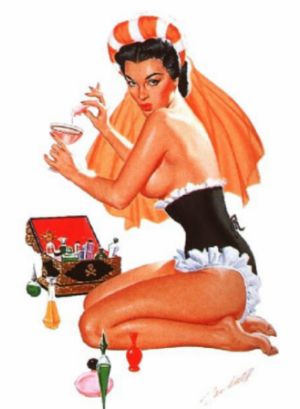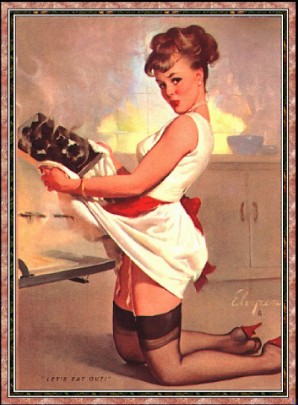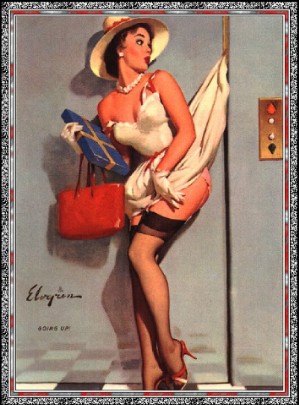Oh La La; A Little Risque In The 50s
I Did Have A Couple Iin My Ham Shack!
Pinup Girls Were Popular In The 1940's and 1950's
 A pin-up girl or pin-up model is a model whose mass-produced pictures see wide appeal as pop culture. Pin-ups are intended for informal display.
A pin-up girl or pin-up model is a model whose mass-produced pictures see wide appeal as pop culture. Pin-ups are intended for informal display.
Pin-up girls are often glamour models, fashion models, and actresses.
Pin-up may also refer to drawings, paintings and other illustrations done in emulation of these photos (see the List of pinup artists). The term was first attested to in English in 1941; however the practice is documented back at least to the 1890s.
The pin up images could be cut out of magazines or newspapers, or be from postcard or chromo-lithographs, and so on. Such photos often appear on calendars, which are meant to be pinned up anyway. Later, posters of pin-up girls were mass-produced.
Many pin ups were photographs of celebrities who were considered sex symbols. One of the most popular early pin-up girls was Betty Grable.
Her poster was ubiquitous in the lockers of G.I.s during World War II. Other pin-ups were artwork, often depicting idealized versions of what some thought a particularly beautiful or attractive woman should look like.
An early example of the latter type was the Gibson girl, drawn by Charles Dana Gibson. The genre also gave rise to several well-known artists specializing in the field, including Alberto Vargas and George Petty, and numerous lesser artists such as Art Frahm.
The term "cheesecake" is synonymous with pin-up photo. The earliest documented print usage of this sense of cheesecake is in 1934 predating pin-up, although anecdotes say the phrase was in spoken slang some 20 years earlier, originally in the phrase (said of a pretty woman) "better than cheesecake".
In the 1950s, for example, there was a magazine called Cheesecake that had a young Marilyn Monroe in a yellow bikini on its cover in 1953.
My Experience Was Limited, Mom Found Out!
In the 1950's I ran across a "pinup" and put it in the garage only long enough so Mom found out and I was toast. I forgot what Mom said but I am sure the word "nasty" was used many times. Sure would be nice to have these back now instead of the filth we see today!!!


Did You Know? - A pin-up girl or pin-up model is a model whose mass-produced pictures see wide appeal as pop culture. Pin-ups are intended for informal display. Pin-up girls are often glamour models, fashion models, and actresses. Pin-up may also refer to drawings, paintings and other illustrations done in emulation of these photos (see the List of pinup artists).




Did You Know? - The term was first attested to in English in 1941; however the practice is documented back at least to the 1890s. The pin up images could be cut out of magazines or newspapers, or be from postcard or chromo-lithographs, and so on. Such photos often appear on calendars, which are meant to be pinned up anyway. Later, posters of pin-up girls were mass-produced.


Did You Know? - Many pin ups were photographs of celebrities who were considered sex symbols. One of the most popular early pin-up girls was Betty Grable. Her poster was ubiquitous in the lockers of G.I.s during World War II.


Did You Know? - Others pin-ups were artwork, often depicting idealized versions of what some thought a particularly beautiful or attractive woman should look like. An early example of the latter type was the Gibson girl, drawn by Charles Dana Gibson. The genre also gave rise to several well-known artists specializing in the field, including Alberto Vargas and George Petty, and numerous lesser artists such as Art Frahm.




Did You Know? - The term "cheesecake" is synonymous with pin-up photo. The earliest documented print usage of this sense of cheesecake is in 1934, predating pin-up, although anecdotes say the phrase was in spoken slang some 20 years earlier, originally in the phrase (said of a pretty woman) "better than cheesecake".



